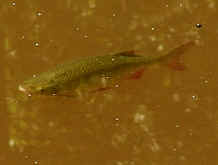| The
Lincoln Index provides a way to measure population sizes of individual animal species. It
is based on a capture /mark / recapture method. In theory,
mark / recapture techniques involve sampling a population of animals and then marking all
of the individuals captured in a recognizable way. The marked animals are then released
back into the population and left to mingle for a suitable period of time. Once they have
become thoroughly mixed into the population again, the population is resampled.
The assumption is then made that the proportion of marked animals in
the second sample is the same as the proportion of marked animals to non-marked within the
whole population. Enough time must be allowed to elapse for complete mixing to have
occurred.
This can be expressed symbolically as follows:
| n1 = number of animals first marked and released. |
| n2 = number of animals captured in the second sample |
| m2 = number of marked animals in the second sample |
| N = Total Population |
| then m2/n2 = n1/N |
Since n2, m2
and n1 are all known, N can be worked out.
Mark / Recapture Techniques |

|
These techniques have a number of limitations:
The animal usually needs to be captured to be marked,
which may injure it, or alter its behaviour pattern.
The mark used may harm the animal - for example a dot
of a particular paint may turn out to be toxic to the animal. Trials therefore need to be
done to ensure that the animal is not harmed in any way.
Marks may be removed in between release and
recapture.
Marks may make individual animals more, or less
attractive to predators than non-marked individuals.
The method assumes that all animals in the population
are equally catchable. However, 'catchability' of animals may vary with different life
stages, seasons, times of day etc. It is therefore better to sample under as similar
conditions as possible and with the same amount of effort.
Trapping responses of animals may vary. Some may
become 'trap-shy' and avoid the traps after the first capture. This can be reduced as far
as possible by choosing a method which will not distress the animal unduly. Some animals
may become 'trap-happy', particularly if the traps are baited. This can be overcome by
setting out the baited traps, without actually trapping, for some time before the first
sample is taken. This allows all animals in the population to become equally trap-happy
before you start.
Trap-shyness results in population overestimates, while trap-happiness results in
population underestimation.
The actual method used to investigate population size
depends on whether you are measuring an open or closed population. A closed population
means one in which you assume there is no immigration or emigration and no births or
deaths. In practice, there are very few completely closed populations. This problem can be
partially overcome by conducting the study over as short a period as possible and at a
time when there are likely to be few changes in population size for any of the above
reasons.
Closed population methods applied to an open
population will produce biased results.
Open population methods produce less precise
estimates of population size.
A great variety of different methods are available.
Each of these involves different assumptions or different statistical calculations to
arrive at a population estimate. One of the simplest of these is the Lincoln Index.
|
The Lincoln Index
The Lincoln Index is a method which is used to estimate
the size of closed populations. Random samples of the population are
captured and these individuals are marked and then released to mingle with the general
population. The population is resampled after enough time has passed to allow complete
remixing of the marked individuals. This will vary depending on the species, as well as
its habitat and mobility. For example, it is likely to take longer for a population
of snails to remix, than for a population of mice. The results are then put into the
following equation to arrive at a population estimate.

or
If the number of animals recaptured in the second
sample is less than 8, then the estimate is likely to be biased.
If there are losses from the population during the
remixing period, then the estimate is for the size of the population at the time of the
first sampling session.
If there are gains, the estimate corresponds to
population size during the second sampling session.
Ecological Sampling
Contents
|





